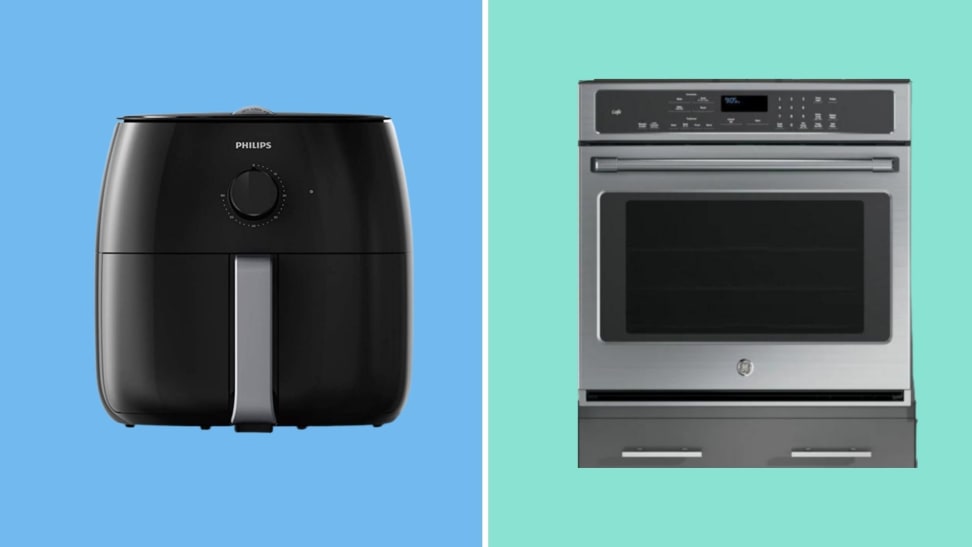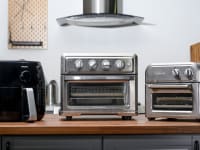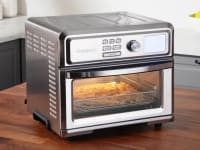 Credit:
Philips / GE / Reviewed
Credit:
Philips / GE / Reviewed
Products are chosen independently by our editors. Purchases made through our links may earn us a commission.
First designed to reheat food on airplanes, the air fryer has come to dominate the kitchen gadget market, going from the must-have “it” gift to a part of a dozen different multi-function spin-offs.
Known for its ability to cook healthier versions of the fried foods we all know and love— hello, french fries and chicken wings—there’s no actual “frying” that happens inside an air fryer. Instead, these gadgets “fry” by circulating incredibly hot air in a short period of time. It’s this rapid circulation that crisps up the food.
If this cooking method sounds familiar to you, it’s because it’s nearly identical to a convection oven, which also circulates hot air around food. But, there’s more to it—read on if you’ve been on the fence about buying either!
The biggest difference is … size

The chief difference between a convection oven and an air fryer is the size.
As mentioned above, an air fryer works by circulating really hot air, really fast. As it turns out, so do convection ovens. So what’s the difference?
Some—but not all—standard ovens come with a convection setting. This setting turns on a fan and an exhaust system that helps circulate hot air to cook food faster and more evenly at lower temperatures. This makes convection ovens great for baking cookies and roasting chicken, for example.
Pro tip: Convection-style cooking is faster than conventional cooking, meaning you’ll have to adjust your recipes accordingly if you’re using an air fryer or a convection oven.
As you probably know, air fryers are a lot smaller than your standard range. That’s because the biggest (pun intended) difference between the two appliances is size.
Since convection ovens are typically larger, you can cook a lot more food at one time than you would be able to in an air fryer.
The convection cooking process eliminates issues of uneven cooking (we’ve all had a turkey come out overdone in one spot but underdone in another!) by streaming and recirculating the hot air throughout the oven chamber, regulating the temperature throughout. This results in flakier pastries, golden-brown roasts, and overall crisper textures.
Our lab tests convincingly show convection settings outperform conventional cooking methods in both uniformity and consistency.
If you're ready to make that investment, our top-performing gas range (the Samsung NX58K9500WG) and electric range (the Whirlpool WGE745C0FS) both offer true convection capabilities.
Air fryers cook more quickly and crisply than a convection oven

Air fryers aren't magic—they're small convection ovens.
One caveat to convection oven cooking: Don’t expect to get the same shattering crunch that you get from using an air fryer.
Because the air fryer is much smaller, food is cooked in a ventilated basket much closer to the heat source and is cooked quicker than it would be in a convection oven. This creates the crispy, brown exterior mimicking food deep-fried in oil.
But since you’re working with limited room, you have to be mindful you’re not loading up the basket with a lot of product at once to prevent uneven cooking.
We recommend investing in our favorite air fryer, the Philips Premium Airfryer XXL, because it produced some of the most tender and crispy fries, chicken tenders, and burgers during testing—even when the basket was fully loaded up.
It’s important to note that just like you can’t expect the same exact texture from a baked versus deep-fried food, the air fryer isn’t going to deliver miracles—even in the best machine.
There are some steps you can take to achieve the best possible results, though. For one, make sure to preheat your air fryer before cooking. Failing to do so could crush your crispy chicken dreams.
Consider the hybrid air fryer

The Cuisinart Air Fryer Toaster Oven is our favorite combo kitchen appliance.
If your kitchen doesn’t offer much counter space, it can be hard to justify buying another appliance. Plus, if you already own a convection oven, you may be thinking about why to bother.
Luckily, the air fryer’s smashing success has resulted in the release of spin-off gadgets, like the air fryer-slash-toaster oven, or the air fryer-slash-grill, that offer the best of both worlds using half the counter space!
At the end of the day, if you’re on the fence about buying either appliance, it really comes down to personal preference. You’ll be able to create the same recipes in either, just in different quantities and at different cooking times.
If you’re trying to achieve that perfect, evenly-cooked roast, a convection oven might be the way to go. But if you’re just looking for an appliance to get your favorite foods cooked fast with less oil, an air fryer might be your best move.
The product experts at Reviewed have all your shopping needs covered. Follow Reviewed on Facebook, Twitter, Instagram, TikTok, or Flipboard for the latest deals, product reviews, and more.
Prices were accurate at the time this article was published but may change over time.


